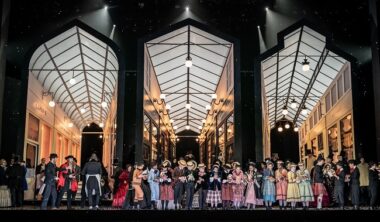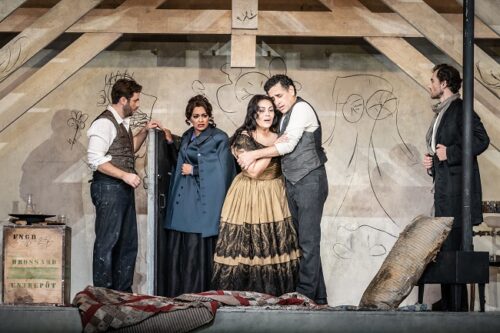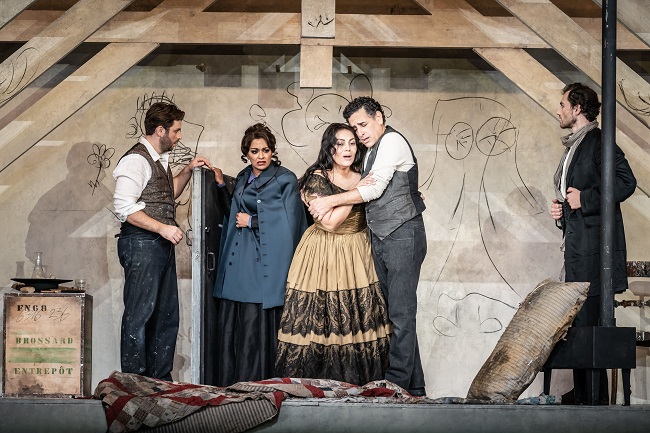 United Kingdom Puccini, La bohème: Soloists, Chorus and Orchestra of the Royal Opera House / Kevin John Edusei (conductor). Broadcast live from the Royal Opera House, Covent Garden, to Cineworld Basildon, Essex, 20.10.2022. (JPr)
United Kingdom Puccini, La bohème: Soloists, Chorus and Orchestra of the Royal Opera House / Kevin John Edusei (conductor). Broadcast live from the Royal Opera House, Covent Garden, to Cineworld Basildon, Essex, 20.10.2022. (JPr)

Production:
Director – Richard Jones
Revival director – Danielle Urbas
Designer – Stewart Laing
Lighting designer – Mimi Jordan Sherin
Movement director – Sarah Fahie
Chorus director – William Spaulding
Cast:
Marcello – Andrey Zhilikhovsky
Rodolfo – Juan Diego Flórez
Colline – Michael Mofidian
Schaunard – Ross Ramgobin
Benoît – Jeremy White
Mimì – Ailyn Pérez
Parpignol – Andrew Macnair
Musetta – Danielle de Niese
Alcindoro – Wyn Pencarreg
Customs Officer – John Morrissey
Sergeant – Thomas Barnard
I often write how in the 1990s I chaired an event with Richard Jones about his (in)famous Ring cycle at Covent Garden and a member of the audience asked him what it all meant, and Jones’s reply was ‘Well, what does it mean to you?’ In 2017 – when his new Covent Garden La bohème premiered – someone asked Jones whether it would be ‘traditional’ and he apparently replied, ‘Please can you tell me what traditional means in this context?’ No guessing from both of these responses that Jones believes the work should speak for itself.
La bohème was Puccini’s fourth opera for the stage; first put on in Turin in 1896, it was not an instant hit with the critics. The next year the Carl Rosa Company presented it in English at Manchester, and a few months later at Covent Garden. On 30 June 1899 it was sung there in Italian and thus became a staple of the repertory. That production basically survived two World Wars until John Copley’s much fêted and oft-revived staging in 1974 which was replaced by Richard Jones’s new one. The success of Copley’s production was its sense of cinematic-style realism involving cast, chorus and extras. There was meticulous research behind the late Julia Trevelyan Oman’s ultra-faithful designs and, as a eulogising programme note once declared, ‘The doors in La bohème work’! It was a ‘jolly good show’ and I suspect sold-out every time it was put on, but I guess it was high time to pension it off and try something new.
I remember I had a terrible journey into London on the first night in 2017 so probably wasn’t in the best of moods and it was good to come back to this La bohème again – albeit in the cinema where it probably benefits from the closeup camerawork – and be able to reassess my first thoughts. Five years ago, I wrote ‘Jones’s replacement is not yet strong enough to fill the Royal Opera House without a stellar cast. Unfortunately, the calibre of singers it really needs are often in much demand and performing elsewhere.’ It is back in 2022 for an extended run of performances with three casts and two conductors, though I wonder if any current – or future? – revival can match the excellence of this performance.
Puccini looks back in La bohème to his own student days – and lost love? – in Milan when he shared a room with Mascagni. (Intriguingly his graduation exercise from the Milan Conservatoire, Capriccio sinfonico, is the music we hear first as the curtain rises.) Those in the cinema saw a fascinating 2017 analysis of the music from The Royal Opera’s music director, Sir Antonio Pappano, and – although he didn’t name them as such – he described how Puccini uses thematic reminiscence which is not far removed from Wagner’s leitmotifs. Here in La bohème, we have themes associated with the bohemians and with Mimì, amongst others. The personable and informative presenter of the broadcast, Elle Osili-Wood, reminded us that Puccini had never actually been to Paris when he wrote his opera set there!
This is a very snowy La bohème and atmospherically some is seen gently falling before any music is heard. This wonderful cast – led by the young-at-heart Juan Diego Flórez – bring great energy to the antics of the bohemians. However, it is never entirely clear what draws them to an extraordinarily sparsely furnished and undecorated Scandinavian-style – and typical of Richard Jones and his collaborators – timber framed ‘garret’. It is doubtful whether it is at the top of a house despite the suggestion of stairs and a ladder to the roof with an extravagant chimney because it is clearly seen at ground level during the third act. There is nothing else on stage apart from one chair, an old tea chest, a small heating stove, a dirty pillow, and some blankets or rugs. There is no easel for Marcello and any ‘painting’ is mimed. This is one of only a few diversions from the ‘traditional’ that includes a lot of singing facing out to the audience, Rodolfo giving Mimì a kick (instead of some water) when she faints, and no one would have trouble finding a missing key in such a rather brightly lit room.
In Act II we see three huge glass-roofed shopping galleries offering all manner of delights which are pushed and pulled into position. Again in typical Jones fashion, it all quickly becomes overcrowded and everyone is crammed into a small space across the front of the stage. More muscle power is needed to change what we see into the Café Momus crammed with tables. Everything is in straight lines and the bohemians, Mimì, Musetta and Alcindoro are all in the first row facing out to the audience once again. While in the opera house it is possible for some of what is going on to be lost in all the hustle and bustle, watching in the cinema helps tremendously because the camera focusses on what you need to see. Therefore, there was no chance anyone would miss Musetta removing her French knickers to enrage her rich admirer, Alcindoro, and make Marcello, her former lover, jealous. Or when Marcello and Musetta share a kiss with a bemused fellow (female) diner!
Act III takes place on a bare snow-covered stage with a single brazier and what looks like a prefabricated wooden tavern. This is where Marcello is painting the outside and Musetta is teaching people to sing. As Rodolfo and Mimì agree to stay together until Spring the small building retreats diagonally across the stage. This is a sublime touch and is as if the couple are trying to distance themselves from real life and Mimì’s impending fate. She is dying of tuberculosis as we know only too well since she clearly has – more than some Mimìs – a racking cough. And expire she will at the end of Act IV, which is played fairly straightforwardly once again, despite the bohemians amusing themselves not with silly dancing but by scribbling all over their apartment. With Mimì having briefly revived Traviata-like, she dies on the floor with her head propped up on the stove which must not have been lit.

Not to dwell on it too much, but the themes of a fatal respiratory disease, food and fuel poverty are so 2022 aren’t they?
Kevin John Edusei – making an impressive Covent Garden debut – conducted an intensely dramatic performance which generally flew by at a cracking pace though he did give Puccini’s evocative and romantic score opportunities to breathe during the biggest moments. Although I was listening though the cinema’s loudspeakers, the orchestra were their usual reliable and virtuosic selves and the Royal Opera Chorus, as well as the children from The Cardinal Vaughan Memorial School and The Grey Coat Hospital School, sang with great enthusiasm and joy on their faces.
Juan Diego Flórez made his reputation as a ‘superstar tenor’ with Rossini and is now moving towards some of the heavier ‘Romantic’ roles. He brought to Rodolfo his trademark vocal beauty and refinement, impeccable diction and elegant, effortless phrasing, as well as ringing top notes, including the one he held on to extravagantly at the end of ‘Che gelida manina’. Ailyn Pérez caressed the long phrases of ‘Sì, mi chiamano Mimì’ winningly and her Act III ‘Donde lieta ne usci’ was heart-wrenching. There was also great between Pérez’s brilliantly acted Mimì and Flórez’s Rodolfo all the more remarkable because the singers had not sung together before these performances.
Danielle de Niese was a superb Musetta with her own vibrant personality and bright soprano voice just perfect for this high-spirited, live life to the full character who is rather provocative and promiscuous at the start, but suitably caring at the end. Andrey Zhilikhovsky made an outstanding Covent Garden debut with his strongly sung Marcello, Michael Mofidian’s cavernous tones made ‘Vecchia zimarra, senti’ another highlight, although I thought Ross Ramgobin – whilst singing well – was a little OTT as Schaunard. To be truthful, Puccini doesn’t give them much to sing and this extends to the even smaller, yet pivotal, roles of Benoît and Alcindoro which got well-characterised vignettes from, respectively, Jeremy White and Wyn Pencarreg, in this enthralling La bohème.
Jim Pritchard
